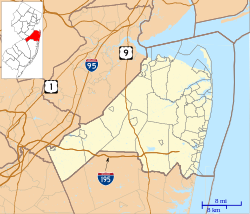Raritan Bay
| Raritan Bay | |
|---|---|

Raritan Bay is shown as highlighted area south of Lower New York Bay and north of Monmouth County.
|
|
| Coordinates | 40°29′00″N 74°10′59″W / 40.48333°N 74.18306°WCoordinates: 40°29′00″N 74°10′59″W / 40.48333°N 74.18306°W |
| Type | Bay |
| Etymology | Raritan Indian tribe |
| Part of | New York Bight |
| Primary inflows |
Primary:
Secondary:
|
| Ocean/sea sources | Atlantic Ocean |
| Basin countries | United States |
| Managing agency |
|
| Max. length | 9 miles (14 km) |
| Max. width | 12 miles (19 km) |
| Surface area | 69,188 acres (27,999 ha) |
| Average depth | 11–30 feet (3.4–9.1 m) |
| Max. depth | 20 feet (6.1 m) |
| Residence time | 60 tidal cycles |
| Salinity | 12-32 ppt |
| Shore length1 | 33,500 acres (13,600 ha) |
| Surface elevation | 0 m (0 ft) |
| Frozen | Coastal or inner bays |
| Benches |
|
| Settlements |
New Jersey New York |
| 1 Shore length is not a well-defined measure. | |
Primary:
Secondary:
New Jersey
New York
Raritan Bay is a bay located at the southern portion of Lower New York Bay between the U.S. states of New York and New Jersey and is part of the New York Bight. The bay is bounded on the northwest by New York's Staten Island, on the west by Perth Amboy, New Jersey, on the south by the Raritan Bayshore communities of Monmouth County, New Jersey, and on the east by Sandy Hook Bay. The bay is named after the Raritans, a branch of the Lenape tribe who lived in the vicinity of the bay for thousands of years prior to the arrival of Dutch colonists in the 17th century.
Archeological evidence suggests that humans were already in the region at the close of the . The early "Big Game Hunters" vanished, but the coastal regions were resettled by peoples accustomed to village-style living ("tidewater communities") that subsisted on hunting and gathering marine shellfish, and eventually, on agriculture. In pre-Columbian times "woodlands cultures" probably centered in the Ohio Valley became the dominant cultural influence in the region. Large shell middens were found around Raritan Bay and on Staten Island, a testament of the utilization of the bay for food by Algonquin Indian tribes (Lenapes) who occupied the area when early Colonialists arrived. Unfortunately, early settlers used these shell piles for road construction and field fertilizer. Tottenville was once well known for its roads paved with oyster shells.
The Raritan River was perhaps the major drainage channel along the ice front throughout the Wisconsin glaciation (Stages 1, 2, 3 and 4). Prior to that time the region drained southward across the saddle between the Atlantic Highlands and the Newark Basin into the Delaware River Valley. This saddle area is a very broad flood plain that preserves river terrace gravels (Pensauken Formation) from the Sangemon Interglacial State (Stage 5), as well as older Pleistocene fluvial deposits (The Bridgetown Formation). During the lowstand in sea level caused by the Wisconsin glacier, the Raritan River carved back into its headlands and captured the major drainages from the Newark Basin.
...
Wikipedia

